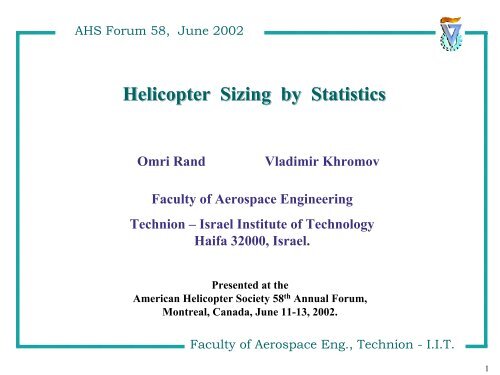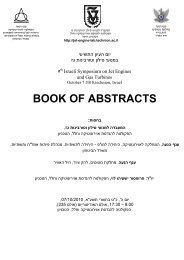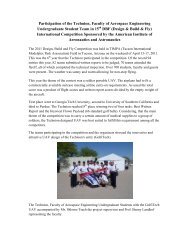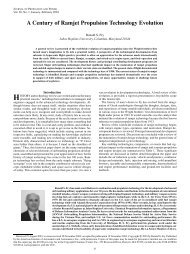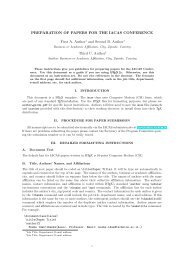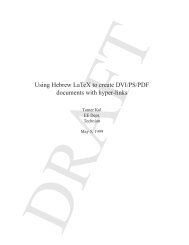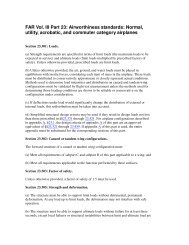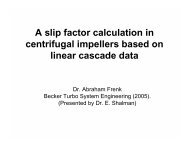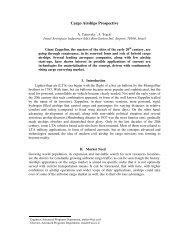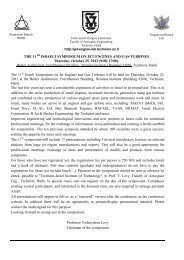Helicopter Sizing by Statistics - Faculty of Aerospace Engineering
Helicopter Sizing by Statistics - Faculty of Aerospace Engineering
Helicopter Sizing by Statistics - Faculty of Aerospace Engineering
Create successful ePaper yourself
Turn your PDF publications into a flip-book with our unique Google optimized e-Paper software.
AHS Forum 58, June 2002<br />
<strong>Helicopter</strong> <strong>Helicopter</strong> <strong>Sizing</strong> <strong>Sizing</strong> <strong>by</strong> <strong>by</strong> <strong>Statistics</strong><br />
<strong>Statistics</strong><br />
Omri Rand Vladimir Khromov<br />
<strong>Faculty</strong> <strong>of</strong> <strong>Aerospace</strong> <strong>Engineering</strong><br />
Technion – Israel Institute <strong>of</strong> Technology<br />
Haifa 32000, Israel.<br />
Presented at the<br />
American <strong>Helicopter</strong> Society 58 th Annual Forum,<br />
Montreal, Canada, June 11-13, 2002.<br />
<strong>Faculty</strong> <strong>of</strong> <strong>Aerospace</strong> Eng., Technion - I.I.T.<br />
1
AHS Forum 58, June 2002<br />
Introduction<br />
• <strong>Sizing</strong> is the first and an important stage in helicopter preliminary design process.<br />
• Preliminary design tools are relatively simple and were developed for fast design cycles.<br />
• “Design trends” analysis is a well known technique in which flying configurations are<br />
analyzed in order to conclude or identify a trend which is common to many configurations,<br />
and therefore, it may represent physical constrains which are not clear and evident at the early<br />
stages.<br />
• “Design trends” analysis is useful for the sizing stage in its broad sense: geometrical<br />
sizing and preliminary “sizing” <strong>of</strong> performance, power required, etc.<br />
• The present study is based on a (partial) database for more than 180 conventional single<br />
rotor helicopter configurations. The analysis has been carried out using advanced<br />
computerized correlation technique which is based on Multiple Regression Analysis.<br />
<strong>Faculty</strong> <strong>of</strong> <strong>Aerospace</strong> Eng., Technion - I.I.T.<br />
2
AHS Forum 58, June 2002<br />
Multiple Regression Analysis (MRA):<br />
The Analysis Methodology<br />
• A computerized algorithm has been coded to generate and select hundreds <strong>of</strong> combinations <strong>of</strong><br />
independent variables, in order to identify the groups that provide high correlation measure.<br />
• The purpose was to find design trends that contain minimal number <strong>of</strong> independent unknowns<br />
(preferably one or two) that exhibit high correlation indicators.<br />
• Error definition:<br />
Y = a Xα 1 Xβ 2 Xγ<br />
3...<br />
ε (%) = 100<br />
| EV - DBV|<br />
DBV<br />
where EV and DBV stand for the estimated value and the database value, respectively. For each case we<br />
shall present the averaged ε and maximum error obtained, defined <strong>by</strong><br />
AVER ε MAX<br />
1<br />
N<br />
∑<br />
i=<br />
1<br />
AVER MAX<br />
ε = ε and ε = max( ε<br />
N i i<br />
ε i<br />
where N is the number <strong>of</strong> configurations involved, is the error calculated for the i-th configuration.<br />
.<br />
<strong>Faculty</strong> <strong>of</strong> <strong>Aerospace</strong> Eng., Technion - I.I.T.<br />
)<br />
3
AHS Forum 58, June 2002<br />
The Analysis Methodology (cont.)<br />
yi yi<br />
R<br />
y y<br />
e<br />
N 2<br />
∑e<br />
− j<br />
2 = 1−<br />
i=<br />
1<br />
N 2<br />
∑e<br />
i − j<br />
i=<br />
1<br />
yi y ye i<br />
Multiple Regression Correlation Measure:<br />
where are the data base values, is the averaged data base value, and are the estimated<br />
values.<br />
Hence, R = 1 stands for a perfect correlation, while in most cases the minimal value <strong>of</strong> R was<br />
set to be above 0.9 in order to conclude that a correlation is <strong>of</strong> a value and represents a genuine<br />
trend.<br />
The Database<br />
The database used is the one stored in RAPID/RaTE (Rotorcraft Analysis for Preliminary<br />
Design / Rand Technologies & <strong>Engineering</strong>) - a desktop rotorcraft analysis package .<br />
RAPID/RaTE is designed to model general rotorcraft configurations, conventional helicopters and<br />
tilt-rotors. RAPID/RaTE performs trim response, mission analysis, vibration analysis, stability<br />
analysis, and both flight mechanics and aeroelastic simulations.<br />
<strong>Faculty</strong> <strong>of</strong> <strong>Aerospace</strong> Eng., Technion - I.I.T.<br />
4
AHS Forum 58, June 2002<br />
The Analysis Methodology Scheme<br />
RAPID/RaTE<br />
<strong>Helicopter</strong><br />
Configurations<br />
DATABASE<br />
<strong>Helicopter</strong><br />
Configuration<br />
Model<br />
Generation <strong>of</strong> helicopter parameters<br />
combinations {X i , i=1,2,…}<br />
Filtering <strong>of</strong> Database configurations for selected<br />
parameters groups<br />
Calculation <strong>of</strong> the MRA parameters<br />
a , α , β , γ ,etc.<br />
and the multiple correlation measure R<br />
AVER MAX c h<br />
Evaluating error estimation ε …...…. , ε<br />
Identification <strong>of</strong> parameter combinations with<br />
high correlation measures<br />
<strong>Helicopter</strong> “Design trends”<br />
<strong>Faculty</strong> <strong>of</strong> <strong>Aerospace</strong> Eng., Technion - I.I.T.<br />
5
AHS Forum 58, June 2002<br />
Vertical tail average chord, ± 12%<br />
Tail Rotor RPM, ± 6.6%<br />
Hover Tip Speed 170-250 m/sec<br />
Main Rotor RPM, ± 6.5%<br />
Hover Rotor RPM, ± 6%<br />
Overall length, rotor turning, ± 1.7%<br />
Fuselage Length, ± 6.2%<br />
Tail Rotor Arm, ± 3.3%<br />
Height to rotor head, ±7%<br />
Vertical tail Arm, ± 4.2%<br />
Width over landing gears, ± 10%<br />
Clearance Fuselage - Ground .3-.7 m<br />
Main Scheme <strong>of</strong> <strong>Helicopter</strong> <strong>Sizing</strong><br />
Fenestron diameter, ± 7.7%<br />
Tail rotor diameter, ± 7.6%<br />
Tail Rotor Solidity<br />
Tail rotor Blade number<br />
Tail Rotor chord, ±10%<br />
Main rotor chord, ±10%<br />
Main rotor Blade number<br />
Main Rotor Solidity<br />
Main Rotor<br />
Diameter, ± 6%<br />
Long range speed, ± 6.5%<br />
Horizontal tail arm, ± 16%<br />
Horiz. tail area, ±29%<br />
Gross<br />
Weight<br />
Disc load<br />
Max speed, S/L<br />
Never exceed speed, ± 5.9%<br />
Range with<br />
standard fuel, S/L<br />
Fuel value (liters), ± 11.5%<br />
Empty Weight, ± 9.3%<br />
Useful load, ± 9.5%<br />
Total power T-O, ± 14.3%<br />
T-O Transmission rating, ± 8%<br />
Total power Max cont., ± 10.5%<br />
Max cont. Transm. rating, ± 9%<br />
<strong>Faculty</strong> <strong>of</strong> <strong>Aerospace</strong> Eng., Technion - I.I.T.<br />
6
FH = f ( D)<br />
c = f ( W0, N B)<br />
σ = f N D c<br />
B<br />
( , , )<br />
Ω= f( D)<br />
AHS Forum 58, June 2002<br />
FL = f ( D)<br />
FLf D<br />
RT = ( )<br />
aMT = f ( D)<br />
aVT = f ( D)<br />
D & D f ( W , V )<br />
LOAD<br />
a = f ( W )<br />
HT<br />
= 0<br />
0<br />
max<br />
<strong>Helicopter</strong> Geometry <strong>Sizing</strong><br />
Parameters<br />
cVT = f ( DTR<br />
)<br />
FW = f ( D)<br />
D = f ( W )<br />
S = f ( W )<br />
<strong>Faculty</strong> <strong>of</strong> <strong>Aerospace</strong> Eng., Technion - I.I.T.<br />
TR<br />
HT<br />
TR<br />
c = f ( W , N )<br />
TR 0 B<br />
= ( , ,<br />
)<br />
TR<br />
σ TR f NB DTR cTR<br />
ΩTR = f ( DTR)<br />
0<br />
0<br />
7
Main Rotor Diameter (m)<br />
40<br />
30<br />
20<br />
10<br />
0<br />
AHS Forum 58, June 2002<br />
Main Rotor Diameter<br />
The " square− cube" scaling law:<br />
D ∝ W 13<br />
0<br />
D = f (W 0) )<br />
D = f (W (GW 0, Vm & V ) max<br />
Estimation<br />
0 10 20 30 40<br />
Main Rotor Diameter Estimation (m)<br />
Error (%)<br />
40<br />
30<br />
20<br />
10<br />
0<br />
7<br />
D = f ( W0)<br />
6<br />
30<br />
21<br />
Average error Max error<br />
D = 0.<br />
980 W 0. 308,<br />
0<br />
D W<br />
AVER ε MAX ε<br />
where is in [ m] and is in [ kg]<br />
( = 7%, = 30%, R = . 9606)<br />
D = 9 . 133 W0. 380 / V0.<br />
515<br />
m ,<br />
0<br />
Vm<br />
is in [ km / hr]<br />
S/ L<br />
AVER MAX<br />
ε ε R<br />
( = 6%, = 21%, = . 9744).<br />
0<br />
D = f ( W0, Vm) <strong>Faculty</strong> <strong>of</strong> <strong>Aerospace</strong> Eng., Technion - I.I.T.<br />
8
Disc Loading (kg/m 2 )<br />
Disc Loading (kg/m 2 )<br />
100<br />
90<br />
80<br />
70<br />
60<br />
50<br />
40<br />
30<br />
20<br />
10<br />
0<br />
AHS Forum 58, June 2002<br />
Main Rotor Disc Loading<br />
0 10000 20000 30000 40000 50000 60000<br />
RAH-66 Comanche<br />
Disc Loading (kg/m 2 )<br />
80<br />
70<br />
60<br />
50<br />
40<br />
30<br />
20<br />
10<br />
0<br />
CH-53E<br />
Mi-6 & Mi-22<br />
Mi-26<br />
Database configurations<br />
RAH-66<br />
Estimation<br />
Comanche<br />
ASI Ultrasport 254<br />
Database configurations<br />
Estimation<br />
0 2000 4000 6000 8000 10000 12000 14000 16000<br />
Gross Weight (kg)<br />
Gross Weight<br />
(kg)<br />
<strong>Faculty</strong> <strong>of</strong> <strong>Aerospace</strong> Eng., Technion - I.I.T.<br />
9
Wing & Disc Loading (lb / f t 2 )<br />
Wing/Disk Loading (lb / f t 2 )<br />
60<br />
50<br />
40<br />
30<br />
20<br />
10<br />
AHS Forum 58, June 2002<br />
0<br />
Wing & Disc Loading Comparison<br />
2.94 (W 1/3 - 6)<br />
[McCormick, 1995]<br />
Fixed-wing<br />
<strong>Helicopter</strong> Database configurations<br />
Disc Loading (rotory-wing)<br />
Wing Loading Upper boundary (fixed-wing)<br />
Wing Loading Lower boundary (fixed-wing)<br />
1.54 (W 1/3 - 6)<br />
[McCormick, 1995]<br />
0 10 20 30 40 50 60<br />
(Gross Weight, lb) 1/3<br />
[Current study]<br />
.334 (W 1/3 - .74)<br />
<strong>Faculty</strong> <strong>of</strong> <strong>Aerospace</strong> Eng., Technion - I.I.T.<br />
10
Wing & Disk Loading (kg/m 2 )<br />
1000<br />
100<br />
10<br />
AHS Forum 58, June 2002<br />
1<br />
Jet transport/bomber<br />
586<br />
30<br />
Fixed-wing<br />
typical loading<br />
[Raymer, 1999]<br />
Wing & Disc Loading<br />
Sailplane<br />
Some transport helicopters<br />
73<br />
20<br />
Rotary-wing<br />
typical loading<br />
[Raymer, 1999]<br />
Civil/utility low<br />
speed helicopters<br />
73<br />
7.5<br />
Rotary-wing<br />
[Current study]<br />
<strong>Faculty</strong> <strong>of</strong> <strong>Aerospace</strong> Eng., Technion - I.I.T.<br />
11
Main Rotor Blade Chord (m)<br />
1<br />
0.8<br />
0.6<br />
0.4<br />
0.2<br />
0<br />
AHS Forum 58, June 2002<br />
Main Rotor Blade Chord & Solidity<br />
Database configurations<br />
Estimation<br />
0 0.2 0.4 0.6 0.8 1<br />
Main Rotor Blade Chord Estimation (m)<br />
c = . W N ,<br />
0108 0540 . / 0.<br />
714<br />
0 b<br />
c W<br />
ε ε<br />
where is in [ m] and 0 is in [ kg]<br />
( AVER = 10%, MAX = 41%, R = . 9535).<br />
<strong>Faculty</strong> <strong>of</strong> <strong>Aerospace</strong> Eng., Technion - I.I.T.<br />
12
Rotor Angular Velocity (RPM)<br />
5000<br />
4500<br />
4000<br />
3500<br />
3000<br />
2500<br />
2000<br />
1500<br />
1000<br />
500<br />
0<br />
AHS Forum 58, June 2002<br />
Main & Tail Rotor Angular Velocity<br />
Main Rotor Database<br />
Main Rotor Estimation<br />
Tail Rotor Database<br />
Tail Rotor Estimation<br />
FENESTRON Database<br />
0 5 10 15 20 25 30 35<br />
Rotor Diameter (m)<br />
<strong>Faculty</strong> <strong>of</strong> <strong>Aerospace</strong> Eng., Technion - I.I.T.<br />
13
AHS Forum 58, June 2002<br />
Main Rotor:<br />
Ω = 2673.<br />
Ω<br />
ε ε<br />
/ D 0<br />
. 829<br />
D<br />
where is in [ RPM] and is in [ m]<br />
( AVER = 6%, MAX = 35%, R = . 9630).<br />
Ω RPM = 3475.<br />
/ D<br />
ε ε<br />
[ ]<br />
0. 828<br />
TR<br />
( AVER = 7%, MAX = 16%, R = . 9737)<br />
or<br />
Main & Tail Rotor Angular Velocity (cont.)<br />
Tail Rotor:<br />
Ω<br />
D<br />
[rad / sec]<br />
where is in [ m].<br />
TR<br />
=<br />
364. /<br />
D<br />
0. 828<br />
TR<br />
Main Rotor Angular Velocity (RPM)<br />
800<br />
600<br />
400<br />
200<br />
0<br />
Database configurations<br />
Estimation<br />
0 200 400 600 800<br />
Main Rotor Angular Velocity Estimation (RPM)<br />
<strong>Faculty</strong> <strong>of</strong> <strong>Aerospace</strong> Eng., Technion - I.I.T.<br />
14
Tip Speed (m/s)<br />
300<br />
250<br />
200<br />
150<br />
100<br />
50<br />
0<br />
AHS Forum 58, June 2002<br />
Main & Tail Rotor Tip Speed<br />
Main Rotor Database configurations<br />
Tail Rotor Database configurations<br />
Fenestron Database configurations<br />
Main Rotor Estimation<br />
Tail Rotor Estimation<br />
0 5 10 15 20 25 30 35<br />
Main Rotor:<br />
Tail Rotor:<br />
Rotor Diameter (m)<br />
V TIP = 140. D 0 . 171,<br />
V TIP m sec<br />
where is in [ / ]<br />
V TIP = 182. D . 172,<br />
V TIP m sec<br />
0 where is in [ / ]<br />
TR<br />
<strong>Faculty</strong> <strong>of</strong> <strong>Aerospace</strong> Eng., Technion - I.I.T.<br />
15
Tail Rotor Diameter (m)<br />
8<br />
7<br />
6<br />
5<br />
4<br />
3<br />
2<br />
1<br />
0<br />
AHS Forum 58, June 2002<br />
USAAMRDL Report 1974:<br />
RAPID/RaTE analysis:<br />
Tail Rotor Diameter<br />
Database configurations<br />
Estimation<br />
FENESTRON Estimation<br />
FENESTRON configurations<br />
0 10000 20000 30000 40000 50000 60000<br />
Gross Weight (kg)<br />
2<br />
D/ D = [. 70÷ 73 .] − . 27DL{ lb/ ft }<br />
TR<br />
2<br />
D/ D = 688 . − . 19DL{ lb/ ft }<br />
TR<br />
D .0895 W 0<br />
TR =<br />
.<br />
D<br />
W<br />
ε ε<br />
where TR is in [ m] and 0 is in [ kg]<br />
( AVER = 8%, MAX = 25%, R = . 9754)<br />
.3081 W<br />
0<br />
0 154 .<br />
<strong>Faculty</strong> <strong>of</strong> <strong>Aerospace</strong> Eng., Technion - I.I.T.<br />
D<br />
TR<br />
F<br />
=<br />
0 391<br />
16
Tail Rotor Arm (m)<br />
25<br />
20<br />
15<br />
10<br />
5<br />
0<br />
AHS Forum 58, June 2002<br />
Tail Rotor Arm<br />
Database configurations<br />
RAPID+ RAPID/RaTE Estimation<br />
Ref. USAAMRDL 13 Estimation Report 1977<br />
0 5 10 15 20 25<br />
Tail Rotor Arm Estimation (m)<br />
USAAMRDL Report 1977:<br />
RAPID / RaTE analysis:<br />
a = . 5107 D 1061 . ,<br />
aMT D<br />
AVER MAX<br />
ε ε<br />
<strong>Faculty</strong> <strong>of</strong> <strong>Aerospace</strong> Eng., Technion - I.I.T.<br />
MT<br />
where and is in [ m]<br />
( = 3%, = 14%, R = . 9907).<br />
a = ( D+ D )/ 2 + . 5feet<br />
MT TR<br />
17
Tail Rotor Blade Chord (m)<br />
0.5<br />
0.4<br />
0.3<br />
0.2<br />
0.1<br />
0<br />
AHS Forum 58, June 2002<br />
Tail Rotor Blade Chord & Solidity<br />
Database configurations<br />
(without FENESTRON)<br />
0 0.1 0.2 0.3 0.4 0.5<br />
Tail Rotor Blade Chord Estimation (m)<br />
c = . W N ,<br />
TR<br />
/ 0<br />
b TR<br />
0058 0506 . . 720<br />
0<br />
c W<br />
ε ε<br />
where TR is in [ m] and 0 is in [ kg]<br />
( AVER = 10%, MAX = 30%, R = . 9437).<br />
<strong>Faculty</strong> <strong>of</strong> <strong>Aerospace</strong> Eng., Technion - I.I.T.<br />
18
Surface Area <strong>of</strong><br />
Horizontal Tail (m 2 )<br />
9<br />
8<br />
7<br />
6<br />
5<br />
4<br />
3<br />
2<br />
1<br />
0<br />
AHS Forum 58, June 2002<br />
Horizontal Tail Surface Area<br />
S = . 0021 W 0. 758<br />
0 ,<br />
HT<br />
S W<br />
ε ε<br />
where HT is in [ m2] and 0 is in [ kg]<br />
( AVER = 29%, MAX = 214%, R = .9117).<br />
Mi-28<br />
Database configurations<br />
Estimation<br />
0 10000 20000 30000 40000 50000 60000<br />
Gross Weight (kg)<br />
Mi-26<br />
<strong>Faculty</strong> <strong>of</strong> <strong>Aerospace</strong> Eng., Technion - I.I.T.<br />
20
Vertical Tail Arm (m)<br />
20<br />
18<br />
16<br />
14<br />
12<br />
10<br />
8<br />
6<br />
4<br />
2<br />
0<br />
AHS Forum 58, June 2002<br />
Vertical Tail Surface Arm<br />
Database configurations<br />
Estimation<br />
0 5 10 15 20 25 30 35<br />
Main Rotor Diameter (m)<br />
a D<br />
= . 5914 0.<br />
995,<br />
a D<br />
ε ε<br />
where VT and are in [ m]<br />
( AVER = 4%, MAX = 20%, R = .9853).<br />
<strong>Faculty</strong> <strong>of</strong> <strong>Aerospace</strong> Eng., Technion - I.I.T.<br />
VT<br />
21
Average Chord <strong>of</strong> Vertical Tail (m)<br />
3.0<br />
2.5<br />
2.0<br />
1.5<br />
1.0<br />
0.5<br />
AHS Forum 58, June 2002<br />
Vertical Tail Average Chord<br />
Database configurations (Diameter < 3.5 m)<br />
Database configurations (Diameter > 3.5 m)<br />
Database configurations (FENESTRON)<br />
Estimation (Diameter < 3.5 m)<br />
Estimation (Diameter > 3.5 m)<br />
Estimation (FENESTRON)<br />
0.0<br />
0 1 2 3 4 5 VT = 6. 297 106 .<br />
TR 7 8TR > 35 . 9<br />
For Fenestron configurations<br />
Tail Rotor Diameter (m)<br />
cVT ≈<br />
DTR<br />
c D 0<br />
VT = 909 . 927<br />
TR Fenestron<br />
cVT = . 161 D 1745 .<br />
TR DTR < 35 . m<br />
ε ε<br />
AVER MAX ( = 12%, = 43%, R = .9709)<br />
c D D m<br />
c D<br />
where and are in [ m]<br />
<strong>Faculty</strong> <strong>of</strong> <strong>Aerospace</strong> Eng., Technion - I.I.T.<br />
.<br />
VT<br />
TR<br />
22
Fuselage Length<br />
40<br />
35<br />
30<br />
25<br />
20<br />
15<br />
10<br />
5<br />
0<br />
AHS Forum 58, June 2002<br />
Configuration Length<br />
Database configurations<br />
Estimation<br />
0 5 10 15 20 25 30 35 40<br />
Main Rotor Diameter (m)<br />
FL 1 D<br />
RT = . .<br />
AVER MAX ε 2%, ε 9%, R<br />
F D<br />
09 103<br />
( = = = .9982)<br />
where and are in [ m].<br />
L RT<br />
FL = 0 . D .<br />
ε ε<br />
F D<br />
824 1 056<br />
AVER MAX ( = 6%, = 17%, R = .9807)<br />
where and are in [ m].<br />
L<br />
0 5 10 15 20 25 30 35 40<br />
Main Rotor Diameter (m)<br />
<strong>Faculty</strong> <strong>of</strong> <strong>Aerospace</strong> Eng., Technion - I.I.T.<br />
50<br />
45<br />
40<br />
35<br />
30<br />
25<br />
20<br />
15<br />
10<br />
5<br />
0<br />
Overall Length, Rotor Turning (m)<br />
23
Height to Rotor Head (m)<br />
9<br />
8<br />
7<br />
6<br />
5<br />
4<br />
3<br />
2<br />
1<br />
0<br />
AHS Forum 58, June 2002<br />
Fuselage Height and Width<br />
FH D<br />
ε ε<br />
F D<br />
( AVER = 7%, MAX = 25%, R = .9371)<br />
where and are in [ m].<br />
Database configurations<br />
Estimation<br />
0 5 10 15 20 25 30 35<br />
F 0 D 0<br />
W = . 436 .<br />
ε ε<br />
F D<br />
AVER MAX ( = 10%, = 40%, R = .8818)<br />
Main Rotor Diameter (m)<br />
697<br />
where and are in [ m].<br />
W<br />
H<br />
= 0. 642 0.<br />
677<br />
EH 101<br />
Mi-26<br />
Mi-6 & Mi-22<br />
0 5 10 15 20 25 30 35 40<br />
Main Rotor Diameter (m)<br />
<strong>Faculty</strong> <strong>of</strong> <strong>Aerospace</strong> Eng., Technion - I.I.T.<br />
8<br />
7<br />
6<br />
5<br />
4<br />
3<br />
2<br />
1<br />
0<br />
Width Over Landing Gears/Skids (m)<br />
24
Clearance Fuselage - Ground (m)<br />
0.8<br />
0.7<br />
0.6<br />
0.5<br />
0.4<br />
0.3<br />
0.2<br />
0.1<br />
0<br />
AHS Forum 58, June 2002<br />
Fuselage-Ground Clearance<br />
0 10000 20000 30000 40000 50000 60000<br />
Gross Weight (kg)<br />
Database configurations<br />
<strong>Faculty</strong> <strong>of</strong> <strong>Aerospace</strong> Eng., Technion - I.I.T.<br />
25
Empty Weight (kg)<br />
35000<br />
30000<br />
25000<br />
20000<br />
15000<br />
10000<br />
5000<br />
0<br />
AHS Forum 58, June 2002<br />
Empty Weight & Useful Load<br />
0 10000 20000 30000 40000 50000 60000<br />
W 0 0<br />
U = . 4709 W . , 0 99<br />
ε ε<br />
( AVER = 10%, MAX = 46%,<br />
R = .9870), where<br />
and are in [ kg]<br />
W W<br />
U<br />
0<br />
<strong>Helicopter</strong> Database configurations<br />
Rotor-wing Estimation<br />
Fixed-wing Estimation [McCormick, 1995]<br />
WE<br />
= 0 . 4854 W 1.<br />
, 0 015<br />
ε ε<br />
( AVER = 9%, MAX = 30%,<br />
R = .9932), where<br />
and are in [ kg]<br />
W W<br />
0 2000 4000 6000 8000 10000 12000 14000<br />
Gross Weight (kg)<br />
<strong>Faculty</strong> <strong>of</strong> <strong>Aerospace</strong> Eng., Technion - I.I.T.<br />
E<br />
Gross Weight (kg)<br />
0<br />
7000<br />
6000<br />
5000<br />
4000<br />
3000<br />
2000<br />
1000<br />
0<br />
Useful Load (kg)<br />
26
Weight Estimation (kg)<br />
14000<br />
12000<br />
10000<br />
8000<br />
6000<br />
4000<br />
2000<br />
AHS Forum 58, June 2002<br />
0<br />
Empty Weight & Useful Load (continued)<br />
0 2000 4000 6000 8000 10000 12000 14000<br />
Gross Weight (kg)<br />
W = W + W + W + W<br />
0<br />
Useful Load Est. + Empty Weight Est.<br />
Empty Weight Estimation<br />
Useful Load Estimation<br />
����� PL �����<br />
F �C<br />
E<br />
W<br />
U<br />
<strong>Faculty</strong> <strong>of</strong> <strong>Aerospace</strong> Eng., Technion - I.I.T.<br />
+<br />
. 4709 W 0. . 4854 W1. 015 W<br />
0 99<br />
0<br />
≅<br />
0<br />
27
Empty Weight / Gross Weight, %<br />
100<br />
90<br />
80<br />
70<br />
60<br />
50<br />
40<br />
30<br />
20<br />
10<br />
0<br />
AHS Forum 58, June 2002<br />
Empty Weight & Useful Load (continued)<br />
Fixed-wing<br />
[McCormick,<br />
1995]<br />
60<br />
50<br />
Fixed-wing<br />
[Raymer,<br />
1999]<br />
70<br />
30<br />
Rotary-wing<br />
[Raymer,<br />
1999]<br />
80<br />
* Group Weight Statement <strong>of</strong> the US military.<br />
<strong>Faculty</strong> <strong>of</strong> <strong>Aerospace</strong> Eng., Technion - I.I.T.<br />
45<br />
*<br />
Rotary-wing<br />
[current<br />
study]<br />
74<br />
42<br />
Upper<br />
bound<br />
Lower<br />
bound<br />
28
Fuel Value (liters)<br />
AHS Forum 58, June 2002<br />
Fuel Value<br />
W = W + W + W + W<br />
0<br />
3000<br />
2500<br />
2000<br />
1500<br />
1000<br />
500<br />
0<br />
����� PL �����<br />
F �C<br />
E<br />
W<br />
U<br />
Database configurations<br />
Estimation<br />
0 500 1000 1500 2000 2500 3000<br />
Fuel Values Estimation (liters)<br />
W<br />
F<br />
Rg<br />
0 0038 W 0976 Rg 0650,<br />
0<br />
= Range with standard fuel at sea level<br />
( AVER = 11%, MAX = 33%, R = .9942),<br />
where WFis fuel value in [ liters], W0is<br />
in [ kg]<br />
,<br />
and is range with standard fuel, S/ L in [ km]<br />
.<br />
Rg<br />
ε ε<br />
= . . .<br />
<strong>Faculty</strong> <strong>of</strong> <strong>Aerospace</strong> Eng., Technion - I.I.T.<br />
29
AHS Forum 58, June 2002<br />
8215 V 1.<br />
0565<br />
M<br />
AVER MAX<br />
( = 6%, = 20%, R = .9399),<br />
,<br />
Speed<br />
where VNE is never exceed speed (S/ L) in [ km / hr], VLR<br />
is long range speed (S/ L) in [ km / hr],<br />
is in [ km / hr]<br />
,<br />
V<br />
M<br />
VNE<br />
= .<br />
ε ε<br />
Speed; S/L (km/hr)<br />
400<br />
350<br />
300<br />
250<br />
200<br />
150<br />
100<br />
50<br />
0<br />
= .<br />
ε ε<br />
Long Range Speed Database configurations<br />
Long Range Speed Estimation<br />
Never Exceed Speed Database configurations<br />
Never Exceed Speed Estimation<br />
V M<br />
5475 V 0899<br />
M<br />
VLR<br />
1.<br />
( AVER = 6%, MAX = 31%, R = .9408),<br />
0 50 100 150 200 250 300 350<br />
Max Speed; S/L (km/hr)<br />
<strong>Faculty</strong> <strong>of</strong> <strong>Aerospace</strong> Eng., Technion - I.I.T.<br />
,<br />
30
Total Power T-O (kW)<br />
25000<br />
20000<br />
15000<br />
10000<br />
5000<br />
0<br />
AHS Forum 58, June 2002<br />
Take-Off Total Power & Transmission Rating<br />
0 10000 20000 30000 40000 50000 60000<br />
Database configurations<br />
Estimation<br />
= . 0366 W 2107<br />
0 ,<br />
T<br />
1.<br />
TO<br />
AVER MAX<br />
( ε = 8%, ε = 22%,<br />
R = .9943), where<br />
TTO<br />
is the take- <strong>of</strong>f<br />
transmission rating<br />
in [ kW]<br />
and W is in [ kg]<br />
0<br />
Gross Weight (kg)<br />
P<br />
1.<br />
TO<br />
AVER MAX<br />
( ε = 14%, ε = 37%,<br />
R = .9891), where<br />
PTO<br />
is the take-<strong>of</strong>f total power<br />
in [ kW]<br />
and W is in [ kg]<br />
0 5000 10000 15000 20000 25000 30000 35000<br />
Gross Weight (kg)<br />
= . 0764 W0<br />
, 1455<br />
12000<br />
10000<br />
8000<br />
6000<br />
4000<br />
2000<br />
<strong>Faculty</strong> <strong>of</strong> <strong>Aerospace</strong> Eng., Technion - I.I.T.<br />
0<br />
0<br />
T-O Transmission Rating (kW)<br />
31
AHS Forum 58, June 2002<br />
Max Continuous Total Power & Transmission Rating<br />
Max Continuous Total<br />
Power (kW)<br />
Max Continuous Total Power Estimation<br />
0 3000 6000<br />
Database<br />
Estimation<br />
9000 12000<br />
P<br />
0 0<br />
MC = . 0013 W . 9876 V . 9760<br />
0 M ,<br />
AVER MAX<br />
( ε = 10%, ε = 37%, R = .9889), where<br />
PMC<br />
is the Max Cont. total power in [ kW],<br />
in [ kg] , is Max speed in [ km/ hr]<br />
12000<br />
9000<br />
6000<br />
3000<br />
0<br />
TMC<br />
= . . .<br />
ε ε<br />
000141 W 09771 V 13393<br />
0 M<br />
( AVER = 9%, MAX = 20%, R = .9870), where<br />
TMC<br />
is the Max Cont. transmission rating<br />
in [ kW],<br />
in [ kg] , is in [ km / hr]<br />
Wis V<br />
0<br />
EH 101<br />
M<br />
CH - 53E<br />
,<br />
Wis V<br />
0<br />
EH 101<br />
<strong>Faculty</strong> <strong>of</strong> <strong>Aerospace</strong> Eng., Technion - I.I.T.<br />
M<br />
0 3000 6000 9000 12000<br />
12000<br />
9000<br />
6000<br />
3000<br />
0<br />
Max Continuous<br />
Transmission rating (kW)<br />
Max cont. transmission rating estimation (kW)<br />
32
AHS Forum 58, June 2002<br />
Power & Transmission Loading<br />
Power loading = the ratio <strong>of</strong> the take <strong>of</strong>f gross weight over the maximum engine power.<br />
Transmission loading = the ratio <strong>of</strong> the take <strong>of</strong>f gross weight over the take-<strong>of</strong>f transmission rating.<br />
Power/Transmission Loading<br />
(kg/kW)<br />
10<br />
9<br />
8<br />
7<br />
6<br />
5<br />
4<br />
3<br />
2<br />
1<br />
0<br />
MINI-500 BRAVO<br />
Transmission Loading Database configurations<br />
Transmission Loading Estimation<br />
Power Loading Database configurations<br />
Power Loading Estimation<br />
0 10000 20000 30000 40000 50000 60000<br />
Gross Weight (kg)<br />
Mi - 26<br />
<strong>Faculty</strong> <strong>of</strong> <strong>Aerospace</strong> Eng., Technion - I.I.T.<br />
33
Power / Transmission<br />
Loading (kg/kW)<br />
10<br />
8<br />
6<br />
4<br />
2<br />
0<br />
AHS Forum 58, June 2002<br />
Propeller powered aircrafts<br />
9<br />
6<br />
Fixed-wing<br />
typical power<br />
loading<br />
[Raymer, 1999]<br />
Power & Transmission Loading<br />
4.9<br />
1.8<br />
Rotary-wing<br />
typical power<br />
loading<br />
[Raymer, 1999]<br />
6.3<br />
2.6<br />
Rotary-wing<br />
power loading<br />
[Current study]<br />
6.4<br />
3.5<br />
Rotary-wing<br />
transmission<br />
loading<br />
[Current study]<br />
<strong>Faculty</strong> <strong>of</strong> <strong>Aerospace</strong> Eng., Technion - I.I.T.<br />
34
AHS Forum 58, June 2002<br />
RAPID/RaTE <strong>Helicopter</strong> <strong>Sizing</strong> S<strong>of</strong>tware<br />
<strong>Faculty</strong> <strong>of</strong> <strong>Aerospace</strong> Eng., Technion - I.I.T.<br />
35
AHS Forum 58, June 2002<br />
Concluding Remarks<br />
• A database for conventional helicopter configurations has been established and<br />
studied using advanced computerized correlation technique which is based on<br />
multiple regression analysis. Design trends were obtained and demonstrated. Currently,<br />
such data can not be found in the open literature.<br />
• The study presented in this paper is expected to give designers a perspective <strong>of</strong> the<br />
existing flying designs and their inter-correlation. This is extremely important in the<br />
early preliminary stages where sizing issues are discussed in order to activate the<br />
preliminary design process.<br />
• The collection <strong>of</strong> design trends presented in this paper contains also valuable<br />
information when comparison <strong>of</strong> performance <strong>of</strong> various configurations is under<br />
discussion.<br />
• The present study results have been implemented as an autonomous component <strong>of</strong><br />
RAPID/RaTE package.<br />
<strong>Faculty</strong> <strong>of</strong> <strong>Aerospace</strong> Eng., Technion - I.I.T.<br />
36


